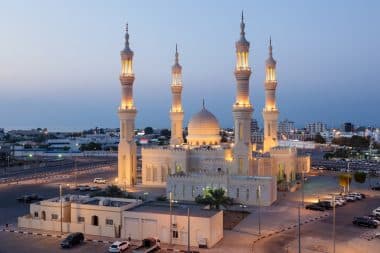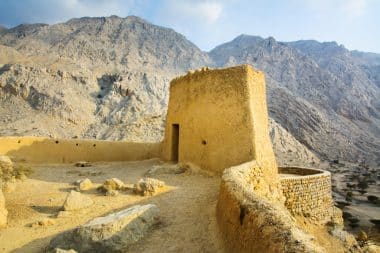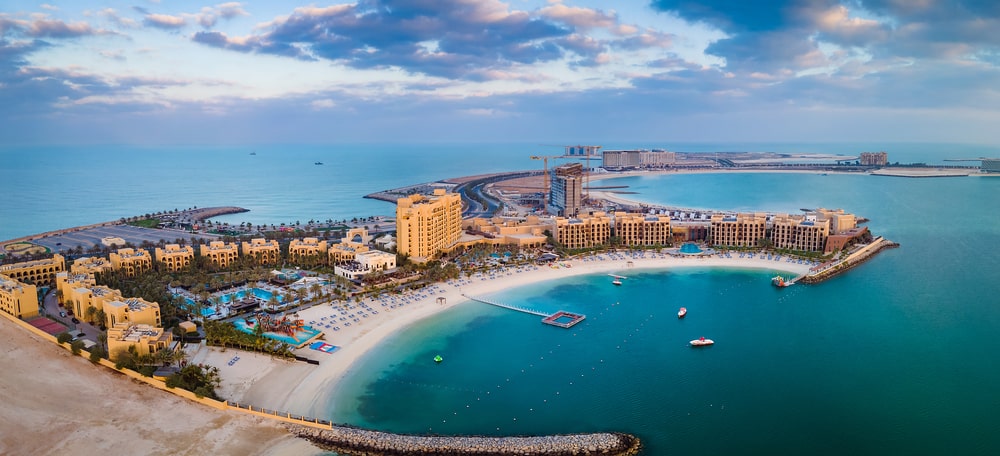Ras Al Khaimah on the Persian Gulf is the northernmost of the United Arab Emirates. Its capital of the same name is the sixth largest city in the Emirates. It is divided by a stream into the old town to the west and Al Nakheel to the east. The impressive old town in traditional oriental construction made of coral stone is located on a narrow headland between the Persian Gulf and a lagoon. The name Ras Al Khaimah means top of the tent and refers to the original way of life of the Bedouins in huts and tents. In the meantime, the region is increasingly developing into a popular tourist destination.
A hidden gem on the Persian Gulf

Ras Al Khaimah is a true holiday paradise by the sea. Warm, clear water and a shallow shore invite you to swim. Sunshine, blue skies and a golden dream beach create perfect conditions for an unforgettable beach holiday. Flamingo Beach on the west coast of the United Arab Emirates is not only loved by sun worshippers and water sports enthusiasts, but also by nature lovers because of its charming landscape and mangrove islands. The beach with its fine white sand has, among other things, a floodlit beach volleyball court. The camels provide a spectacle worth seeing when they run to the sea to take a dip in the lukewarm waters of the Gulf.
Because it is visited by significantly fewer tourists compared to Dubai and Abu Dhabi , the emirate is still considered an insider tip. Nevertheless, the up-and-coming region has a good tourist infrastructure and luxurious resorts along the coast. In addition to impressive shopping malls such as Al Hamra Mall or Manar Mall, there are numerous fine restaurants. The authentic oriental souks, as the business districts of Arab cities are called, have their own charm. In the bazaars, local traders offer their wares at colourful market stalls, including enchanting exotic souvenirs.
Exciting attractions can be found further inland from Ras Al Khaimah. A drive through moon-like desert landscapes, abandoned villages and the barren rocky wadis to the spectacular summit of Jebel Jais is a truly magical experience. Just before the summit is an observation deck that offers stunning views of the Hajar Mountains, the desert landscape, and the gulf.
On the highest mountain in the United Arab Emirates lies the Bear Grylls Explorer Camp. Here you will find the exciting high ropes course Jais Ropes Course. With the world’s longest zip line, Jais Flight, you glide at breathtaking speed over rugged mountain peaks and through deep gorges. The comfortable bobsleighs of the Jais Sledder glide down the mountains on rails close to the ground. They reach speeds of up to 40 kilometers per hour and offer magnificent panoramic views of the spectacular coast.
Amid the rolling dunes of the Ras Al Khaimah desert lies the home of the proud Arabian horses, the Al Wadi Equestrian Adventure Centre. It is located in a nature reserve for the delicate ecosystem of the desert. In the untouched nature, it is not uncommon to meet native animals such as oryx antelopes, camels, desert foxes and desert cats.
In addition to an impressive landscape with exotic nature and fascinating wildlife, Ras Al Khaimah offers numerous interesting and historic excursion destinations.
A country with a long history and ancient traditions

Deep in the dunes of the endless sandy desert of Ras Al Khaimah is the Bassata Bedouin Camp, the replica of a typical Bedouin village. Bassata means simplicity. This refers to the traditional way of life of the desert nomads. Visitors get the opportunity to learn about the life and traditions of the Bedouins. This also includes a ride in a camel caravan.
To the northeast, on a hilltop amidst the barren mountains and fertile date wadis of Ras Al Khaimah, rises the Dhayah Fort. The only surviving fortress in the Emirates dates back to the 18th century. It is located in an oasis and offers spectacular views from the mountains over palm trees and green land to neighboring Oman and the sea.
Al Jazirah Al Hamra, the red island, is the only remaining historic pearl village in the entire Gulf region. The place was originally a tidal island and around 1830 home to 200 inhabitants, who were mainly engaged in pearl fishing. In the meantime, the city has become an open-air museum, but it is neither supervised nor maintained.
The National Museum of Ras Al Khaimah, housed in a centuries-old fort, houses regional history and archaeological exhibitions. The archaeological excavations in more than 1000 sites prove a lively trade in the region with India, China and Mesopotamia since 5,000 BC. Numerous ancient monuments bear witness to the origin of the emirate. Near the fish market is the Mohammed Bin Salem Mosque, one of the oldest and most important in the Emirates. Interestingly, it lacks the typical minaret.


